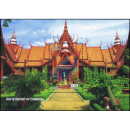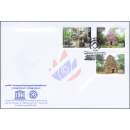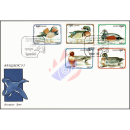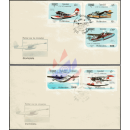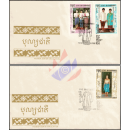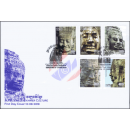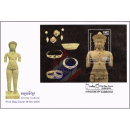Description
Opr. (2x5 + 2x5); A = perf. K 13; B = imperforated
FDC(I), Issue Date: 17.09.2018
Picture Descriptgion:
drk-dro) Exhibits in the National Museum
drk) Stoneware for "Prahok" (12 Cen.)
drl) Jayavarman VII Sand Stone Statue (12 / 13 Cen.)
drm) Buddhist Triad of Bronze (13 Cen.)
drn) Kinnari Box - Betel Box of Wood (19 / 20 Cen.)
dro) Reclining Vishnu of Bronze (11 Cen.)
drp) The courtyard of the National Museum
2619 A 500 R multicolored drk
2620 A 800 R multicolored drl
2621 A 2000 R multicolored drm
2622 A 3000 R multicolored drn
2623 A 4000 R multicolored dro
Quantity FDC(I): 200 pieces
Printer: Vietnam Printing
Designer: Cambodia Post
Conservation Status:
Here as a FDC (Version I) with first day special postmark
Issue Notice:
- MiNo. 2619 - Prahok is a staple for Khmer cuisine. It is made from salted, fermented fish and has a strong odour. A large container is called a ?peang? and a smaller one called ?kralor?. Both are used for the same purpose. This particular vessel is used to preserve ?Prahok?. The widest section is the mouth, which must be wider than a person?s forearm to enable them to use their hands to insert the ?Prahok? into the vessel.
- MiNo. 2620 - This statue is dated to the Bayon style. Portraiture art of this period is marked by smiling and mystical expression. The quality of the modelling of this work reveals an exceptional mastery of the art. His facial expression is accentuated by semi-closed eyes, a light smile, nose with three lobes, large forehead, lips that are neither thin nor thick, and long ear lobes. All these traits represent the Khmer physiognomy. The king?s power as expressed by his facial expression evokes supreme knowledge, compassion and peacefulness.
- MiNo. 2621 - This triad represents the combination of Hinayana and Mahayana sects and illustrates the unification of Cambodia's religions. Mahayana Buddhism was predominant during the reign of Jayavarman VII (1181-1218). It is represented by Lokesvara or Avalokitesvara (male divinity) and Prajnaparamita (female divinity). They are both Bodhisattva and have an Amitabha on their chignon symbolizing eternal radiance.
- MiNo. 2622 - This box is in the form of duck with human head. It is made of lacquered wood painted red. The decoration is carved directly into the wood. Its base is a oval in shape and the cover represents the wings of the bird. The shape of the head is a human head with a mitre, which proves this figure is that of a celestial dancer (Kinnari). Traditionally, most elder Khmer women chew betel. This container may have been used for keeping betel nut and leaves.
- MiNo. 2623 - Khmer bronze production began from the Neolithic period (5,000BCE) and reached its apogee during the Angkor period (Baphuon style). The technique used continuously until the present-day is the ?cire-perdue? or ?lost-wax ? process. Some statues were inlaid in the eye cavities with precious stones to make them more life-like. The art of inlay was undeniably widespread throughout Southeast Asia in the 11th century.

